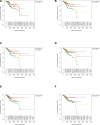Four differentially expressed exosomal miRNAs as prognostic biomarkers and therapy targets in endometrial cancer: Bioinformatic analysis
- PMID: 37653757
- PMCID: PMC10470766
- DOI: 10.1097/MD.0000000000034998
Four differentially expressed exosomal miRNAs as prognostic biomarkers and therapy targets in endometrial cancer: Bioinformatic analysis
Abstract
Endometrial cancer (EC) is one of the most common gynecological malignancies worldwide. Accumulated evidence has demonstrated exosomes of cancer cells carry microRNAs (miRNAs) to nonmalignant cells to induce metastasis. Our study aimed to find possible biomarkers of EC. Data for miRNA expression related with exosome from EC patients were downloaded from The Cancer Genome Atlas database, and the miRNA expression profiles associated with exosomes of EC were downloaded from the National Center for Biotechnology Information. We used different algorithms to analyze the differential miRNA expression, infer the relative proportion of immune infiltrating cells, predict chemotherapy sensitivity, and comprehensively score each gene set to evaluate the potential biological function changes of different samples. The gene ontology analysis and Kyoto encyclopedia of genome genomics pathway analysis were performed for specific genes. A total of 13 differential miRNAs were identified, of which 4 were up-regulated. The 4 miRNAs, that is hsa-miR-17-3p, hsa-miR-99b-3p, hsa-miR-193a-5p, and hsa-miR-320d, were the hub exosomal miRNAs that were all closely related to the clinic phenotypes and prognosis of patients. This study preliminarily indicates that the 4 hub exosomal miRNAs (hsa-miR-17-3p, hsa-miR-99b-3p, hsa-miR-193a-5p, and hsa-miR-320d) could be used as prognostic biomarkers or therapy targets in EC. Further studies are required to make sure of their real feasibility and values in the EC clinic and the relative research.
Copyright © 2023 the Author(s). Published by Wolters Kluwer Health, Inc.
Conflict of interest statement
The authors have no funding and conflicts of interest to disclose.
Figures







Similar articles
-
Differential expression of exosomal microRNAs in fresh and senescent apheresis platelet concentrates.Platelets. 2022 Nov 17;33(8):1260-1269. doi: 10.1080/09537104.2022.2108541. Epub 2022 Aug 14. Platelets. 2022. PMID: 35968647
-
Development of a necroptosis-related prognostic model for uterine corpus endometrial carcinoma.Sci Rep. 2024 Feb 21;14(1):4257. doi: 10.1038/s41598-024-54651-3. Sci Rep. 2024. PMID: 38383747 Free PMC article.
-
Hsa-microRNA-181a is a regulator of a number of cancer genes and a biomarker for endometrial carcinoma in patients: a bioinformatic and clinical study and the therapeutic implication.Drug Des Devel Ther. 2015 Feb 18;9:1103-75. doi: 10.2147/DDDT.S73551. eCollection 2015. Drug Des Devel Ther. 2015. PMID: 25733820 Free PMC article.
-
Bioinformatic analysis reveals an exosomal miRNA-mRNA network in colorectal cancer.BMC Med Genomics. 2021 Feb 27;14(1):60. doi: 10.1186/s12920-021-00905-2. BMC Med Genomics. 2021. PMID: 33639954 Free PMC article.
-
Exosomal hsa-miR-151a-3p and hsa-miR-877-5p are potential novel biomarkers for predicting bone metastasis in lung cancer.Aging (Albany NY). 2023 Dec 18;15(24):14864-14888. doi: 10.18632/aging.205314. Epub 2023 Dec 18. Aging (Albany NY). 2023. PMID: 38180107 Free PMC article.
Cited by
-
Possible Role of Endothelial-Derived Cellular and Exosomal-miRNAs in Lipid-Mediated Diabetic Retinopathy: Microarray Studies.Cells. 2024 Nov 15;13(22):1886. doi: 10.3390/cells13221886. Cells. 2024. PMID: 39594634 Free PMC article.
-
Exosomal ncRNAs in reproductive cancers†.Biol Reprod. 2025 Feb 14;112(2):225-244. doi: 10.1093/biolre/ioae170. Biol Reprod. 2025. PMID: 39561105 Free PMC article. Review.
-
Upregulation of miR-17-3p is associated with HbF in patients with β-thalassemia and induces γ-globin expression by targeting BCL11A.Orphanet J Rare Dis. 2025 May 30;20(1):260. doi: 10.1186/s13023-025-03806-0. Orphanet J Rare Dis. 2025. PMID: 40448206 Free PMC article.
-
Identification of hsa-miR-193a-5p-SURF4 axis related to the gut microbiota-metabolites- cytokines in lung cancer based on Mendelian randomization study and bioinformatics analysis.Discov Oncol. 2024 Sep 27;15(1):475. doi: 10.1007/s12672-024-01359-5. Discov Oncol. 2024. PMID: 39331265 Free PMC article.
References
-
- Sung H, Ferlay J, Siegel RL, et al. . Global cancer statistics 2020: GLOBOCAN estimates of incidence and mortality worldwide for 36 cancers in 185 countries. CA Cancer J Clin. 2021;71:209–49. - PubMed
-
- Lu KH, Broaddus RR. Endometrial cancer. N Engl J Med. 2020;383:2053–64. - PubMed
-
- Siegel RL, Miller KD, Fuchs HE, et al. . Cancer statistics, 2022. CA Cancer J Clin. 2022;72:7–33. - PubMed
MeSH terms
Substances
LinkOut - more resources
Full Text Sources

